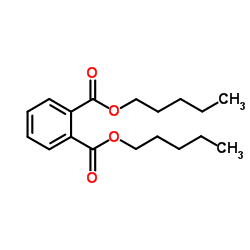Accelerated degradation of dipentyl phthalate by Fusarium oxysporum f. sp. pisi cutinase and toxicity evaluation of its degradation products using bioluminescent bacteria.
Ji-Young Ahn, Yang-Hoon Kim, Jiho Min, Jeewon Lee
文献索引:Curr. Microbiol. 52(5) , 340-4, (2006)
全文:HTML全文
摘要
The efficiency of two lipolytic enzymes (fungal cutinase and yeast esterase) in the degradation of dipentyl phthalate (DPeP) was investigated. The DPeP degradation rate of fungal cutinase was surprisingly high, i.e., almost 60% of the initial DPeP (500 mg/L) was decomposed within 2.5 hours, and nearly 40% of the degraded DPeP disappeared within the initial 15 minutes. With the yeast esterase, despite the same concentration, >87% of the DPeP remained even after 3 days of treatment. The final chemical composition after 3 days was significantly dependent on the enzyme used. During degradation with cutinase, most DPeP was converted into 1,3-isobenzofurandione (IBF) by diester hydrolysis. However, in the degradation by esterase, pentyl methyl phthalate, in addition to IBF, was produced in abundance. Toxicity monitoring using various recombinant bioluminescent bacteria showed that the degradation products from yeast esterase contained a toxic hazard, causing oxidative stress and damage to protein synthesis.
相关化合物
| 结构式 | 名称/CAS号 | 分子式 | 全部文献 |
|---|---|---|---|
 |
邻苯二甲酸二戊酯
CAS:131-18-0 |
C18H26O4 |
|
Analysis of phthalates in milk and milk products by liquid c...
2014-10-03 [J. Chromatogr. A. 1362 , 110-8, (2014)] |
|
Developing structure-activity relationships for the predicti...
2010-07-19 [Chem. Res. Toxicol. 23 , 1215-22, (2010)] |
|
A predictive ligand-based Bayesian model for human drug-indu...
2010-12-01 [Drug Metab. Dispos. 38 , 2302-8, (2010)] |
|
Rapid screening and identification of multi-class substances...
2015-03-20 [J. Chromatogr. A. 1386 , 22-30, (2015)] |
|
The ultrastructural effects of di-n-pentyl phthalate on the ...
1987-06-01 [Exp. Mol. Pathol. 46(3) , 357-71, (1987)] |